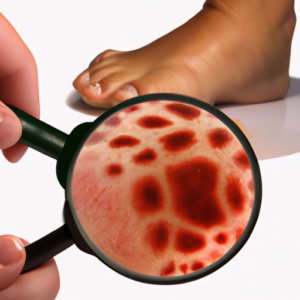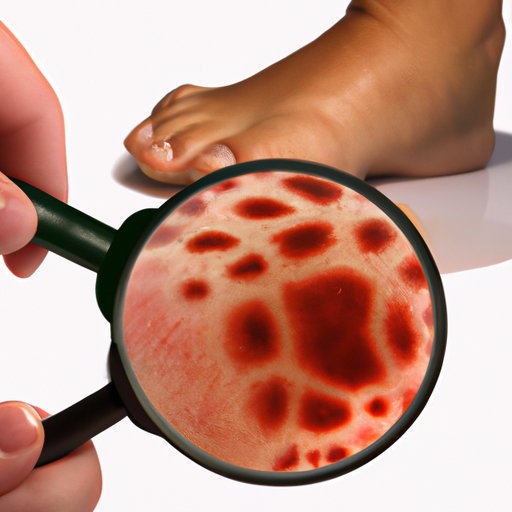Let’s talk about Tinea: What it is and how to deal with it
Hey there, folks! Today I want to chat with you about tinea, a fungal infection that can affect the skin, scalp, and nails.
First off, let me define what tinea is. It’s a type of fungal infection caused by different types of dermatophyte fungi. These fungi live on the skin and feed on keratin, a protein found in hair, nails, and skin. When the fungi multiply and invade the skin, tinea can develop.
If you have tinea, you might experience some uncomfortable symptoms, such as itching, burning, and scaly patches on the skin. These symptoms can differ depending on the type of tinea you have, including tinea capitis, tinea corporis, tinea cruris, and tinea pedis.
To accurately diagnose tinea, a doctor may use different methods, including visual inspection, skin scrapings, and a Wood’s lamp test. Once diagnosed, treatment often involves using antifungal creams or oral antifungal medications.

But how can you prevent tinea from occurring in the first place? It’s crucial to keep your skin, hair, and nails clean and dry, change your socks often, wear sandals in public areas, avoid sharing personal items such as towels or hairbrushes, and seek treatment right away if you notice any symptoms.
So, there you have it – tinea in a nutshell. Don’t let this pesky fungal infection get the best of you – take the necessary steps to prevent and treat it.
Feelin’ Itchy? Burning? Scaly patches? It Might Be Tinea
Symptoms of Tinea can be fairly straightforward, and may include itching, burning or a scaly rash. The itchiness and burning may be the most notable at first, and the rash can develop over time. It can be frustrating and uncomfortable, but it’s important to identify and treat it quickly to prevent it from spreading and causing further problems.
If you notice any of these symptoms, it’s important to not scratch the affected area, as this can further irritate the skin and make treatment more difficult. Keep the area clean and dry, and avoid using any harsh soaps or chemicals on the skin. Over-the-counter anti-fungal creams and powders may help ease the itching and burning, but it’s important to speak with a healthcare provider before using any medication.
If left untreated, Tinea can worsen and spread to other areas of the body or to others. It’s important to see a healthcare provider to determine the best course of treatment and prevent the spread of the infection.
Types of Tinea: The Different Forms of Fungal Skin Infections
When it comes to tinea infections, there are several different types that can affect the skin. Each type of tinea infection has its own set of symptoms and treatment options. Here are some of the most common types of tinea:
Tinea capitis
This is a type of fungal infection that affects the scalp and hair. It often appears as a patch of scaly, itchy skin with bald patches and is typically most common in children.
Tinea corporis
Tinea corporis is a fungal infection affecting the skin of the body. It presents as a flat, red ring with a raised border and can be itchy or painful. It can be spread through direct skin-to-skin contact or through contact with infected objects like towels and clothes.
Tinea cruris
Also known as jock itch, tinea cruris is a fungal infection that affects the groin and inner thighs. It typically presents as a red or brown patch of scaly skin with a defined edge, and can also be itchy or painful.
Tinea pedis
Commonly referred to as athlete’s foot, tinea pedis is a fungal infection of the feet. It is often characterized by dry, itchy, and scaly skin between the toes, or on the soles or sides of the feet.
If you suspect that you have any of these types of tinea infections, it’s important to seek medical attention to receive prompt treatment.
Figuring out Tinea: Diagnosing the Fungal Infection with Ease
Identifying tinea is a crucial step towards treating it effectively. As someone who has battled the condition before, I’ve picked up a few tips on how to diagnose the fungal infection. Here are the three primary methods:
1. Visual Inspection
Your doctor can recognize tinea symptoms by examining the affected area. Symptoms include itchiness, scaly patches, and a burning sensation. Visual inspection can work well for diagnosing tinea corporis and tinea cruris, which affect the body and groin.
2. Skin Scrapings
If your symptoms persist, your healthcare provider will use a blade or scalpel to take a sample of your skin, hair, or nail debris. Then, they’ll analyze the sample under a microscope to check for fungal elements. This method is ideal for diagnosing tinea capitis, which affects the scalp.
3. Wood’s Lamp Test
A Wood’s lamp is a specialized ultraviolet lamp that can help identify tinea by highlighting infected areas on your skin. Your doctor will examine your skin’s response under the Wood’s lamp to determine the presence of fungal elements. While the test is less accurate compared to other methods, it’s still cost-effective and used frequently to diagnose tinea pedis, which affects the feet.
It’s crucial to seek medical attention and diagnose tinea precisely to prevent complications or misdiagnosis. Proper diagnosis can establish the right course of treatment-which can effectively cure tinea in weeks.
Blast Tinea with Antifungal Creams and Meds!
So, now that you have diagnosed the cause of that persistent itch and redness, it’s time to treat your Tinea effectively. There are two main types of treatment – antifungal creams and oral antifungal medications. Let’s discuss them both.
Antifungal creams are usually the first line of treatment for Tinea and are available over-the-counter or by prescription. They contain active ingredients like terbinafine, clotrimazole, miconazole, or ketoconazole that kill the fungus and prevent it from spreading. You should apply the cream to the affected area as directed by your physician, twice a day for at least two weeks after the rash has disappeared. Remember to cover the surrounding areas as the fungus may have also spread there.
If your Tinea is stubborn, recurring, and hasn’t improved even after using antifungal creams for several weeks, your doctor may prescribe oral antifungal medications like griseofulvin, itraconazole, or fluconazole. These medicines are taken orally for a few weeks to months and are highly effective in treating Tinea capitis (which affects the scalp) or when Tinea has spread extensively on the body. Oral antifungal drugs can cause side effects, so your doctor will monitor you closely and may recommend periodic blood tests to check for liver damage.
In addition to medications, you should also keep the affected area clean and dry, avoid scratching or picking the rash, and follow your doctor’s advice and hygiene recommendations. Tinea can be very contagious, so you must avoid sharing towels, combs, clothes, and bed linen with others. If you have Tinea pedis (athlete’s foot), wearing sandals or open-toed shoes in public or crowded places like locker rooms, swimming pools, and spas can prevent the spread of the fungus.
Remember, self-treating Tinea or ignoring it can lead to long-term complications. If you have diabetes or a weakened immune system, Tinea can cause severe infections, so do not hesitate to seek medical attention if your condition worsens or if new symptoms emerge.
Prevention and Outlook: Keep Your Feet Fungus-Free
Now that you know all about tinea and its various types, you’re probably wondering – how do I prevent it from happening to me? Luckily, there are some simple steps you can take to reduce your risk of developing tinea, especially if you’re prone to fungal infections like athlete’s foot.
First of all, wearing sandals or flip-flops in public areas like pools, locker rooms, and showers is key. This helps prevent the spread of fungal infections from one person to another. Additionally, always make sure to dry your feet well after showering and to change your socks frequently. Avoid sharing personal items like towels or shoes with others, as this can also spread fungal infections.
If you’re someone who sweats a lot or spends a lot of time in humid environments, it’s especially important to keep your skin dry and clean. Consider using an antifungal powder or spray on your feet before putting on socks or shoes.
It’s also important to note that if you do develop tinea, it’s highly treatable with antifungal creams or oral medications. Follow your doctor’s instructions and be sure to complete the full course of treatment, even if your symptoms start to improve before the medication is finished.
In summary, preventing tinea is all about keeping your feet clean, dry, and protected in public areas. If you do develop tinea, don’t worry – it’s easily treatable and shouldn’t cause any long-term problems.
My Final Thoughts On Tinea
Well folks, that brings us to the end of our discussion on tinea. It’s clear from everything we’ve gone over that this fungal infection can be quite unpleasant, to say the least. From the intense itching and burning to the unsightly scaly patches that it causes, it’s no wonder that so many people dread getting tinea.Now, if you do find yourself dealing with tinea, it’s important to remember that there are ways to treat it effectively. In fact, according to this fantastic article I found (check it out here!), there are plenty of options for curing tinea that are not only effective but also affordable and easy to find.Of course, one of the best things you can do to protect yourself from tinea is to take steps to prevent it in the first place. This means wearing sandals in public areas, changing your socks often, avoiding sharing personal items like towels and clothes, and keeping your skin as clean and dry as possible.Overall, my advice to all of you out there is simple: if you think you might have tinea, don’t panic! With the right treatment and prevention strategies, you can quickly and easily get rid of this pesky fungal infection and get back to enjoying your life.
